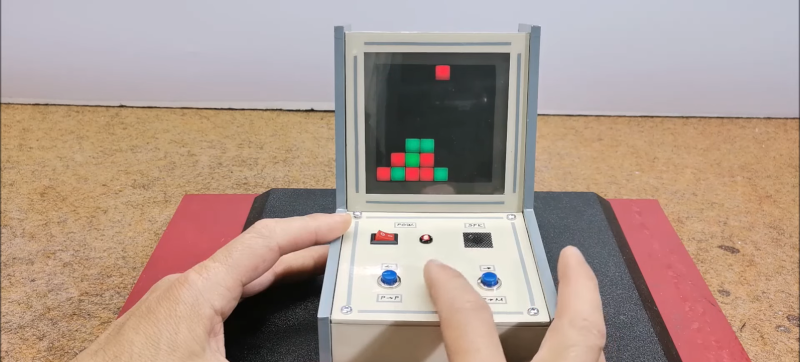You might think that making your own electronic games would require some kind of LCD, but lately, [Mirko Pavleski] has been making his using inexpensive 8X8 WS2812B LED panels. This lets even a modest microcontroller easily control a 64-pixel “screen.” In this case, [Mirko] uses an Arduino Nano, 3 switches, and a buzzer along with some 3D printed components to make a good-looking game. You can see it in action in the video below.
The WS2812B panels are easy to use since the devices have a simple protocol where you only talk to the first LED. You send pulses to determine each LED’s color. The first LED changes color and then starts repeating what you send to the next LED, which, of course, does the same thing. When you pause a bit, the array decides you are done, and the next train of pulses will start back at the first LED.
It looks like the project is based on a German project from [Bernd Albrecht], but our German isn’t up to snuff, and machine translation always leaves something to be desired. Another developer added a play against the computer mode. This is a simple program and would be easy to port to the microcontroller of your choice. [Mirko]’s execution of it looks like it could be a commercial product. If you made one as a gift, we bet no one would guess you built it yourself.
Of course, you could play a real robot. You could probably repurpose this hardware for many different games, too.















“but our German isn’t up to snuff, and machine translation always leaves something to be desired.”
“Paging Mr. Williams!
Mr. Elliot Williams! “
It should be easy to program the electronic opponent to always win by always starting in the center then playing perfectly. https://www.youtube.com/watch?v=yDWPi1pZ0Po
Once you know the secret there’s no point in playing against anyone else who knows it. Pick a victim who doesn’t know and let them go first. If they start in one of the outer 4 columns you’ve already won. If they start in the columns to either side of the center they may be able to play you to a draw, if they make no errors.
If you beat them every time, especially if they start in the center when it’s their turn, tell the secret. It’ll either ruin the game for them or they’ll find someone who doesn’t know it to beat consistently.
A hallmark of old school gaming, the state space of the game is so small you can find an algorithm that can always win.
8 x 8 x 60mA gives ~3.8A when full brightness applied…
But one can also limit the peak power envelope for the LED array at the driver level (like FastLED does) and control it with a PID loop and a ambient light sensor…
Only if all pixels are on and displaying white. Looks like its only red of green, so tahts 20mA max per pixel. Not to mention that I’m not sure connect 4 you can have all slots filled without someone winning meaning it’ll never get to 64 x 20mA. So 1A tops.
That, and those LEDs are so bright that, unless you’re out in direct sun, you generally run them at under 10% brightness, which is a lot less power obviously.
I did it, including my new 3D printed shell
https://youtu.be/lNqOZIrtk8g?si=XRFzeyxjOt_Wq0mU
I would like to thank the author first